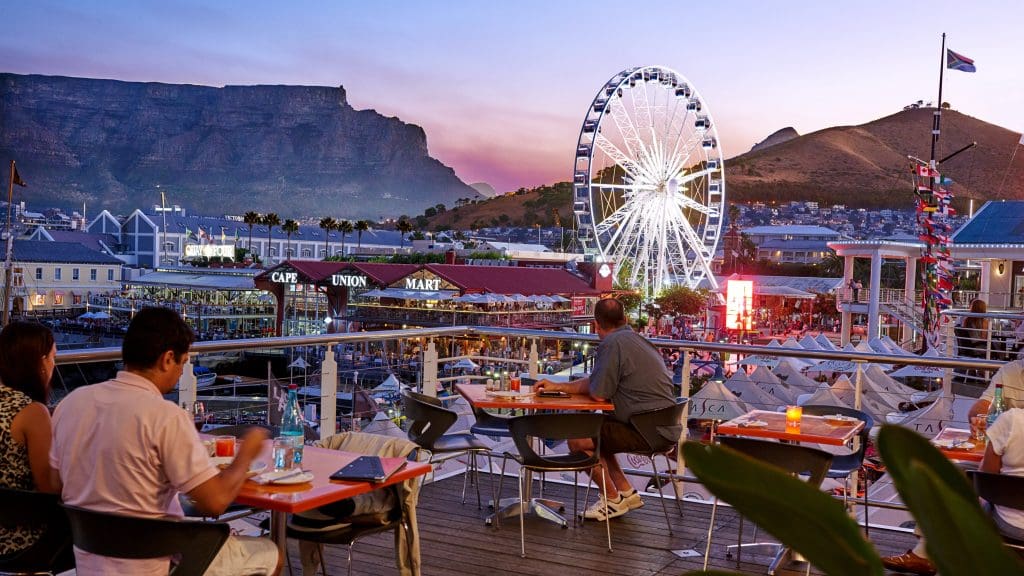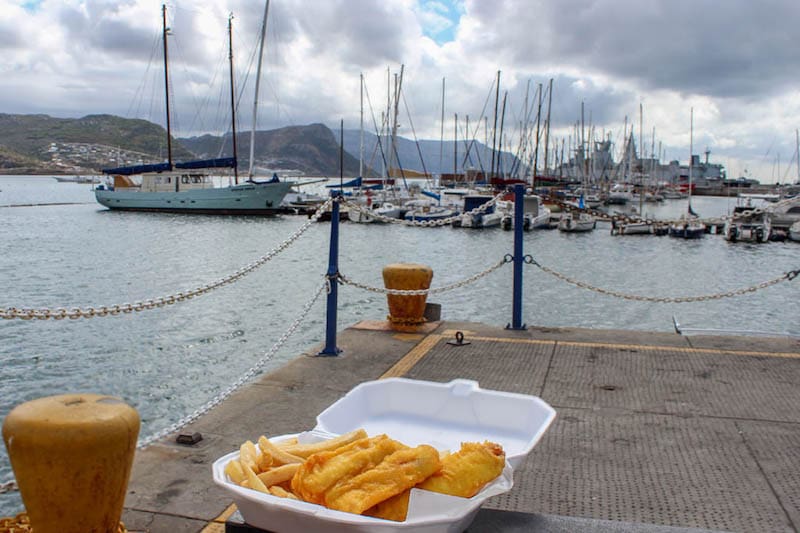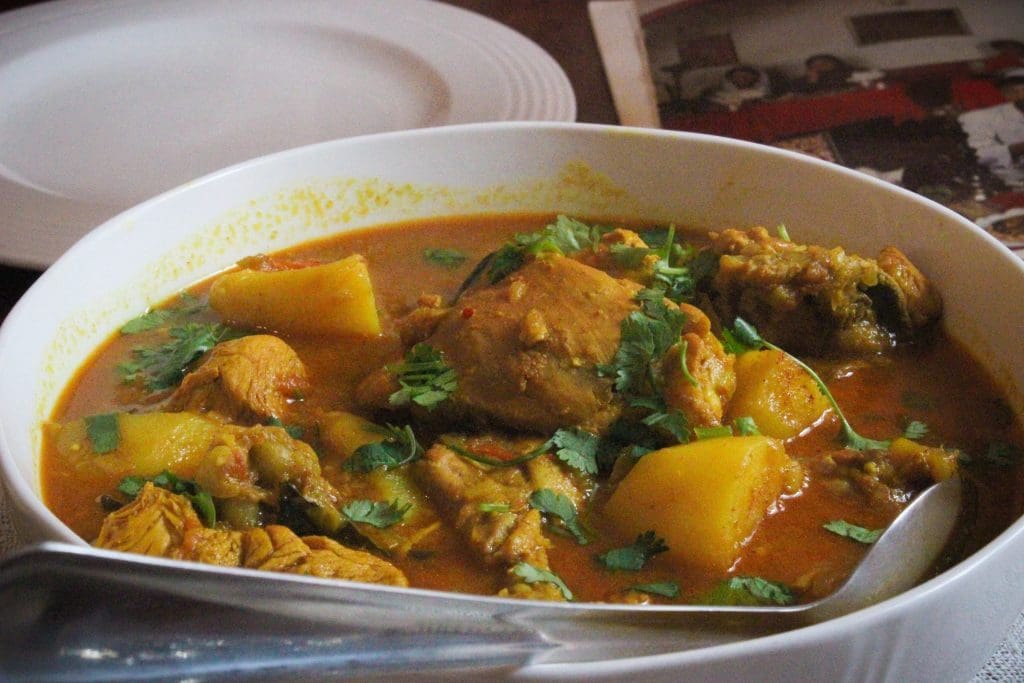Situated between the ocean and Table Mountain, Cape Town, South Africa is known for its spectacular views. Wherever you are in the city, you’re sure to have something beautiful to look at. One of the best ways to enjoy that amazing view is over a delicious meal.
Founded in 1652, Cape Town, South Africa has been home to people from many different cultures which has left a mark on the food in this wonderful city. Local food embodies influences from the Dutch, French and British settlers, the Malay who were brought there as slaves, and the indigenous Khoisan people, and the Xhosa tribes from the East.
While Cape Town is an international city and you can taste flavors from all over the world, there are some foods you should really sample during your stay.
Here’s our picks for your Cape Town South Africa food bucket list.
Seafood Dinner on the V & A Waterfront

No matter where you stay in Cape Town, you’ll probably end up on the V&A Waterfront within the first day or two of arriving in the city. Be sure to head over in the evening and enjoy cocktails, then treat yourself to a delicious seafood dinner from one of the fish restaurants on the waterfront.
There are a number of good restaurants nearby including Baia Seafood Restaurant (comes with a Portuguese twist), Knysna Oyster Company and the Cape Town Fish Market. Cape Town is right on the coast, so your meal is guaranteed to be fresh and delicious.
As a bonus, seafood in Cape Town is also quite affordable compared to many other countries.

Fish and Chips on the beach in Hout Bay
For a more rustic fish meal, try fish and chips. A staple in Britain and its colonies across the world, fish and chips in South Africa is best enjoyed on the beach in beautiful Hout Bay. It is a bit of a drive to get there, but the scenery on the way is stunning.
In Hout Bay head to Snoekies, one of the oldest fish and chips shops in the city and a Cape Town institution. Here you’ll find fresh fish and Cape Town-style “slap chips” (crispy on the outside and soft on the inside). Eat them on the wharf surrounded by panoramic views of the ocean.
Winery Lunch in the Cape Winelands

For something a bit more upmarket, head out of the city centre to the Cape Winelands for a winery lunch. Stellenbosch is a popular option and there are a number of wineries serving up delicious food.
Try Rust en Vrede Wine Estate for simple, delicious food in a Colonial Dutch building, or the Delaire Graff Restaurant for a fine dining experience. There’s a wide range of local wines in the area, so be sure to taste a few while you’re there.
If you don’t have time to head out of Cape Town, visit Groot Constantia, South Africa’s first vineyard, near the city center. With beautiful views of the surrounding valleys, Groot Constantia gives you a taste of the winelands. They offer two restaurants, good wine to taste and an old homestead. There’s also an on-site museum worth visiting.
Cape-Malay Cooking Class in Bo-Kaap

To truly get a taste of culture, you need to try Cape Malay cooking. Cape Malay food is a fusion of the flavors slaves from Malaysia, Indonesia and East Africa brought to Cape Town in the 17th and 18th centuries. Usually prepared at home, Cape Malay cooking includes aromatic spiced stews, curries and roasts which often contain a hint of sweetness through the addition of dried fruit.
A cooking class in Bo Kaap is the best way to try Cape Malay food and take some of these unique dishes home with you. Bo Kaap is known for its history and colorful houses, and the cooking classes offered there are perfect for travelers of all levels of cooking ability.
First you prepare the dishes, usually in the cook’s home, then sit down and enjoy the meal (and often a glass of wine) with the class. It’s a wonderful window into a part of Cape Town’s history and the food is sure to be delicious.
South African Steakhouse Dinner at The Husser Grill
Braaing (or barbecuing) meat is very common in South Africa. Some hotels occasionally have braais, otherwise the best way to try South African style grilled meat is at a local steakhouse.
The Husser Grill is a popular chain with high-quality meat, however there are many steakhouses to choose from. Expect a meat-heavy menu including various cuts of steak (with sauces), ribs and chicken, usually served with coleslaw and fries.
Some game restaurants also have more unusual options such as grilled ostrich, springbok, warthog, and impala.
Gatsby

A truly Capetonian food, the Gatsby originated in the Cape Flats (an area in the north of Cape Town where thousands of households from various racial and ethnic groups were forcibly relocated during Apartheid) in the 1970s.The Gatsby is a huge submarine-style sandwich filled with assorted meats, chips, and sauces.
It’s cheap and filling – in fact, most people don’t manage to finish a whole Gatsby. With that in mind, order a half portion and be sure to get yours from a small hole-in-the-wall spot like Bona Fast Food, The Golden Dish or Cosy Corner.
Biltong
Biltong is a cured, dried meat, similar to jerky, and very popular in South Africa. This cured meat can be made from beef or venison, or more unusual meats like ostrich or kudu.
Spices can range from sweet to spicy. Cuts can be lean or a bit fattier, with some types being chewier while others are tender.
If this is your first time in South Africa, be sure to give it a try. Readily available from many shops, sample a range during your time in Cape Town.
Conclusion:
Cape Town’s culinary scene reveals the heart and soul of the city in and of itself, meaning everything goes beyond just the meals. The waterfront and V&A Waterfront brings forth an ever vibrating hustle and bustle while the Cape Winelands serene view offers awe-inspiring calm. These locations and their beauty serves to enhance the flavor of everything. Cape Town is exceptionally unique and because of that, the dishes served at the restaurants are not simply for eating, they have extravagant histories, cultures, and backgrounds to be savoured.
Cape Town also provides invaluable opportunities to learn about the city’s evolution through its food. The vibrant blend of culinary arts from Malay, British, Dutch, and the indigenous Xhosa and Khoisan offerttetogethertetha termagolia. The aromatics and taste of each dish has adifferenthistorical city during cape that makes them unique and aids in their vibrancy. These flavors serve as a testament for the incredible and colorful past of South Africa.
Cape Town is a culinary destination that requires no introduction, particularly for its Malay curry which one would describe as breathtaking. Equally important is the cape’s “Cape Town”(what locals on the beach would call it) where seafood is served at the V and A Waterfront with an added twist, also known as surfing. Cape Town also hosts extraordinary South African braai which is a barbeque at the peak. One can enjoy fish and chips right at the beachfront. Cape Town caters to all those with varying tastes regardless of whether or not they appreciate the pale drink served threw through the beat rivers of the winelands. Each and every person gets to have memorable experience, all at the same time.
Cape Town has much more to offer than just restaurants and cooking lessons.
Additional Resources
Check out our other Food Bucket lists for Lisbon and Abu Dhabi.


